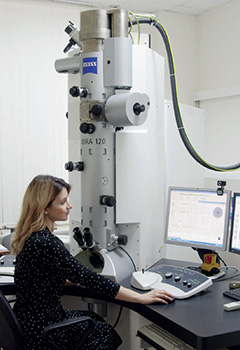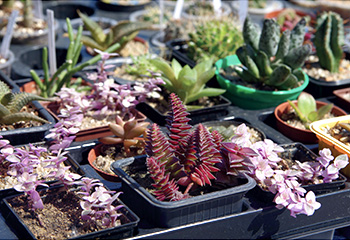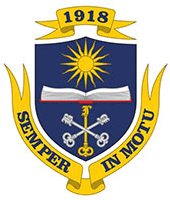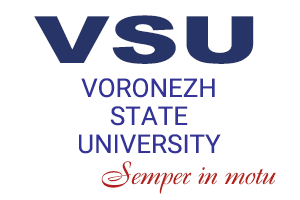Laboratories (Other departments)
- Laboratory of Mathematical Hydrodynamics of the Research Institute for Mathematics
- VSU Centre for the Collective Use of Scientific Equipment
- Green laboratories at the greenhouse complex; Seed Laboratory and Herbarium (VORG); Laboratory of Plant Biotechnology of VSU Botanical Garden
- Laboratory of the Nursery for Carnivorous Birds of “Galichya Gora” Nature Reserve
- Supercomputer Centre
Laboratory of Mathematical Hydrodynamics of the Research Institute for Mathematics (Research Institute for Mathematics)
Research area
Studying the problems of mathematical hydrodynamics
Laboratory equipment
- Sentinel V50 (500kHz) acoustic Doppler current profiler used to measure water current velocities over a range of depths
- Immersion autonomous high performance temperature sensors RBR soloT (12)
- Immersion autonomous high performance temperature sensors RBR soloT (3)
- Autonomous inertialess water temperature sensors RBR Duo (2)
- Thermistor strings (2)
Available research methods
- Modern functional analysis methods
- Topological approximation approach to studying the problems of mathematical hydrodynamics
- Experimental and numerical methods
Challenges
Current problems of mathematical hydrodynamics
Major projects
Grants of the Government of the Russian Federation for the state support of research conducted by the leading scientists in universities, research institutions, and state research centres of the Russian Federation (contract No. 14.Z50.31.0037 of 09.02.2017)
 VSU Centre for the Collective Use of Scientific Equipment
VSU Centre for the Collective Use of Scientific Equipment
The centre is comprised of 5 laboratories
- Structural Study Laboratory
- Molecular Biology Laboratory
- Nanoscopy and Nanotechnology Laboratory
- Electron Microscopy Laboratory
- Physicochemical Research Methods Laboratory
Industrial partners
- OAO NII PM (Voronezh)
- AO RIF (Voronezh)
- OOO ISOMETRICA
- OOO TIGI Cramer
- OOO Suvorovskoye Rudoupravleniye
- AO VZPP-S
Collaboration with the leading Russian research centres:
- Joint Institute for Nuclear Research (Laboratory of Nuclear Physics) (Dubna)
- A.A. Baikov Institute of Metallurgy and Material Science of the Russian Academy of Sciences (IMET RAS)
- Lomonosov Moscow State University
- A.A. Maximov Space Systems Research and Development Institute of the Khrunichev Space Center
- B.P. Konstantinov St. Petersburg Nuclear Physics Institute
- OAO Chemical Automatics Design Bureau
- OAO Concern Rosenergoatom
- Novovoronezh nuclear power station
Collaboration with the leading international research centres:
- BESSY II at Helmholtz Zentrum Berlin (Germany)
- Synchrotron Radiation Center Alladin (USA)
- International Centre for Diffraction Data JCDD (USA)
- National technical university Kharkov Polytechnical Institute (Ukraine)
Research area
- Nanosystem industry
- Bioscience
- Natural resource management
- Transport and space systems
- Energy efficiency, energy conservation, and nuclear energy
The centre’s equipment
- Thermo ARL X'TRA powder X-ray diffraction system (Thermo Fisher Scientifics, Switzerland)
- Vertex 70 series FT-IR spectrometer (Bruker Optik GmbH, Germany)
- MPA series FT-IR spectrometer (Bruker Optik GmbH, Germany)
- Lambda 650 spectrometer with a URA module (Perkin Elmer, USA)
- Simadzu UV-2550 spectrophotometer (Shimadzu Scientific Instruments, Japan)
- JSM-6380LV Series Electron Microscope (JEOL Ltd., Japan)
- JSM-6510LV Series Electron Microscope (JEOL Ltd., Japan)
- INCA Energy 250 microanalysis system (Oxford Instruments, UK)
- SOLVER P47 scanning probe microscope (NT-MDT, Russia)
- Renom-01 X-Ray spectrometer (ZAo NTTs Expertcentre, Russia)
- Fluke 5520A multifunction calibrator (Fluke, USA)
- Fluke 8508A/01 multifunction measurement instrument (Fluke, USA)
- Zeiss LIBRA 120 transmission electron microscope (Carl Zeiss, Germany)
- PANalytical Empyrean X-ray diffractometer (PANalytica, Netherlands)
- BrukerS8 Tiger X-ray diffractometer (Bruker, Germany)
- QUANT-Z-ETA-1 atomic absorption spectrometer (OOO Kortek, Russia)
- Agilent 6230 accurate-mass time-of-flight (TOF) LC/MS system (Agilent Technologies, USA)
- IonPersonal Genome Machine (DNA sequencing system) (Ion Torren, USA)
- U-2900 double beam spectrophotometer (Hitachi, Japan)
- Chromo4 real-time PCR detection system (BioRad, USA)
- Amersham Imager 600 Western Blotting complex (GE Healthcare, USA)
- Agilent 7890B/5977A gas chromatograph (Agilent Technologies, USA)
- Bruker X-flash energy dispersive system (Bruker, Germnay)
- Akta start GE chromatography system (Healthcare, Switzerland)
- Nikon ECLIPSE Ni-E/Ni-U optical microscope (Nikon, Japan)
- SONICATOR Q500 ultrasonic dispergator (QSONICA, USA)
- Zetasizer Nano ZSP (Malvern, UK)
- IKA RV-10 rotary evaporator (IKA, Germany)
- Guava easyCyte 8 HT benchtop flow cytometer (EMD Millipore, France)
- Akta Pure 150L chromatography system (GE Healthcare, Sweden-UK)
- PT-PC 75840 RMC-Boeckeler rotary ultramicrotome (RMC-Boeckeler, USA)
- Plazma 50-SE for ultrathin coating (NIIPM, Russia)
- Q150R S/E/ES sample preparation system (Quorum Technologies, UK)
Available research methods
- Determining the phase compositions of powders and thin films by means of X-ray diffractometry
- Determining temperature limits for the thermal phase transitions (25-1100°С) of powder and thin-film samples by means of X-ray diffractometry
- Determining the qualitative and semiquantitative elemental composition of powders and thin-film samples of the elements with the molar mass 40 g/mol by means of X-ray luminescence method
- Calculating and modelling of the crystal lattice of an unknown powder or thin film by means of X-ray diffractometry
- Determining the degree of texture of thin-film materials by means of X-ray diffractometry
- Determining the average grain size of polycrystalline alloys by means of X-ray diffractometry
- Studying thin-film materials and determining their interplanar distances by means of X-ray diffractometry
- Studying thin-film materials by means of transmission electron microscopy
- Studying thin-film and bulk materials, determining the phase composition, and orientation of crystallites in the reflection setup by means of the electron graphical method
- Determining the thickness of films and separate layers of heterostructures by means of electron microscopy
- Studying the surface morphology, determining the lateral extent of the inhomogeneity layer, and height distribution by means of scanning electron microscopy
- Performing qualitative and quantitative element composition analysis of conductor materials in a high vacuum by means of energy dispersion methods
- Performing qualitative and quantitative element composition analysis of conductor materials in a high vacuum by means of energy dispersion methods
- Studying surface morphology by means of atomic force microscopy
- Studying the surface roughness and height distribution by means of atomic force microscopy
- Studying mono- and polycrystalline bulk and film samples of semiconductor and dielectric materials in order to determine the parameters of electron-photon interaction in the self-absorption, excitonic absorption, intracentre extrinsic absorption, and inter-band absorption by measuring the transmission and absorption spectra
- Studying organic and inorganic compounds, determining their concentrations and dependencies between optical properties and chemical processes taking place in these compounds by measuring the absorption spectra
- Studying mono- and polycrystalline bulk and film samples of narrow-bandgap semiconductor and dielectric materials in order to determine the parameters of electron-photon interaction in the self-absorption, excitonic absorption, intracentre extrinsic absorption, and inter-band absorption by measuring the transmission and absorption spectra
- Measuring the scattering absorption spectra of medicinal products for express quality control by means of IR-spectroscopy
- Measuring the absorption spectra of oil products for express quality control by means of IR-spectroscopy
- Measuring the scattering absorption spectra of sugar beet seeds in order to evaluate their quality by means of IR-spectroscopy
- Studying the chemical interactions within various chemical processes by measuring the transmission spectra in solid and liquid samples of organic and incorganic origin in the mid-infrared region (4000–400 cm–1)
- Performing real-time PCR (polymerase chain reaction) detection
- Determining the elemental composition of solutions by means of atomic absorption spectroscopy
- X-ray fluorescence wavelength-dispersive qualitative and quantitative analysis of chemical elements of F-Am range and their stoichiometric compounds. The analysis can be performed in vacuum, low pressure helium (liquids and loose samples), and atmospheric pressure (volatile liquids)
- Identifying copper in rock formations and ores by means of X-ray fluorescence spectroscopy
- Identifying copper, zinc, and lead by means of X-ray fluorescence spectroscopy and internal standards
- Identifying cobalt, copper, nickel, lead, and zinc in rock formations, ores, and their by-products by means of X-ray fluorescence spectroscopy
- Identifying fluorine, sodium, magnesium, aluminium, silicon, phosphorus, potassium, calcium, scandium, titanium, vanadium, chromium, manganese, iron, cobalt, nickel, strontium, zirconium, and niobium in rock formations, ores, and their by-products by means of X-ray fluorescence spectroscopy
- Identifying foreign elements in soil, bedload sediment, and rock formations by means of X-ray fluorescence spectroscopy
- Identifying the major elements of silicate minerals, bauxites, carbonate rocks, and banded iron formations by means of X-ray fluorescence spectroscopy
- Determining the genotoxicity of various materials
- Determining the cytotoxicity of various materials
- Production of liposomes and liposome drug loading methods
- Studying thermal phase transition of solid and liquid samples in a wide temperature range
- Registering the spatial structure of various microscopic objects by means of confocal laser microscopy
- Identification, determining the structure, purity analysis (quality control), and control over the concentrations of chemical compounds (quantitative analysis) in order to develop techniques for express analysis and control
Challenges
- Transmission electron microscopy
- Determining phase compositions of thin films
- Determining phase compositions and carrying out structural analysis of materials (thin films, nanopowders, thinned bulk material, biomaterial) as thin as 0.20 nm
- Studying surface morphology using the replica method
- Scanning electron microscopy
- Obtaining nanometre resolution images of conductor and nonconductor materials
- Determining the thickness of alloys and separate layers of heterostructures by means of scanning electron microscopy
- Performing element composition analysis of conductor and dielectric materials
- Auger electron spectroscopy
- Analysis of the elemental composition of metals and semiconductors, and the distribution of impurities in depth by means of ion etching
- Studying adsorption and desorption on solid surfaces, as well as corrosion and phenomena occurring during surface heterogeneous catalysis
- Atomic force microscopy
- Obtaining nanometre resolution images of conductor and nonconductor materials by means of atomic force microscopy at temperatures of up to 130°С
- Determining surface parameters (roughness, elevation difference, the extent of the inhomogeneity layer, analysis of the probability of distribution in height) using an atomic force microscope
- Pore size analysis
- Making tables of objects allocation and their characteristics for surfaces with discretely allocated (inhomogeneous) objects
- Determining the domain structure in magnetic and piezoelectric materials and defining the domain size
- X-ray diffractometry
- X-ray phase analysis with automatic search of elements and existing compounds in ICDD PDF-2 databases
- Qualitative and quantitative phase analysis of alloys, powders, and crystals
- Studying the kinetics of phase transitions of alloys, powders, and crystals in vacuum with temperature changes of up to 1,000°С
- Phase analysis of thin films on substrates, with the influence of the substrate excluded
- Determining the degree of texture of thin-film materials
- Determining the average grain size of polycrystalline materials
- Chromatography and optical research methods
- Studying the properties of new composite materials (highly ordered composites, high performance sorbents, and highly specific catalysts for materials with set properties)
- Identifying the presence of metals and metalloids in solid, liquid, and gaseous samples of various substances in medium, trace, and ultratrace levels with a sensibility of up to 10-10%
- Analysis of medicinal products and body fluids
- Identifying and confirming the structure of biomolecules and therapeutic proteins in biomarkers
- Identification, determining the structure, purity analysis (quality control), and control over the concentrations of chemical compounds (quantitative analysis) in order to develop techniques of express analysis and control
- Studying the chemical interactions within various chemical processes by measuring the transmission spectra in solid and liquid samples of organic and incorganic origin in mid-infrared region (4000–400 cm–1)
- Determining the parameters of electron-photon interaction in the self-absorption, excitonic absorption, intracentre extrinsic absorption, and inter-band absorption by measuring the transmission, absorption, and reflection spectra of mono- and polycrystalline bulk and film samples of narrow-bandgap semiconductor and dielectric materials
- Analysis of oxygen and carbon contents in silicon wafers
- Developing express methods of quality control of medical products when measuring the scattering absorption spectra Creating databases of the spectra of pharmaceuticals in the near-infrared region
- Developing express methods of quality control of motor fuels and oils when measuring the absorption spectra
- Measuring the mass fraction of aluminium, barium, beryllium, vanadium, bismuth, iron, cadmium, potassium, calcium, cobalt, silicon, lithium, magnesium, manganese, copper, molybdenum, arsenic, sodium, nickel, tin, lead, selenium, silver, strontium, antimony, thallium, tellurium, titanium, chromium, and zinc in fresh, natural, and waste water by means of atomic absorption spectroscopy
- Molecular biology methods
- Determining the structure of molecules and their hydration properties
- Studying the heterogeneous electrochemical reactions, membrane and ion-exchange transport of physiologically active substances, water, and low molecular weight electrolytes
- Identifying and studying the level of genes expression by means of real-time quantitative PCR, northern blot, and transformation of bacteria in order to create DNA libraries
- X-ray fluorescence spectroscopy
- X-ray fluorescence wavelength-dispersive qualitative and quantitative analysis of chemical elements of F-Am range and their stoichiometric compounds. The analysis can be performed in a vacuum, low pressure helium (liquids and loose samples), and atmospheric pressure helium (volatile liquids)
Identifying copper in rock formations and ores by means of X-ray fluorescence spectroscopy (a certified method) - Identifying copper, zinc, and lead by means of X-ray fluorescence spectroscopy and internal standards
- Identifying cobalt, copper, nickel, lead, and zinc in rock formations, ores, and their by-products by means of X-ray fluorescence spectroscopy (a certified method)
- Identifying fluorine, sodium, magnesium, aluminium, silicon, phosphorus, potassium, calcium, scandium, titanium, vanadium, chromium, manganese, iron, cobalt, nickel, strontium, zirconium, and niobium in rock formations, ores, and their by-products by means of X-ray fluorescence spectroscopy (a certified method)
- Identifying foreign elements in soil, bedload sediment, and rock formations by means of X-ray fluorescence spectroscopy (a certified method)
- Identifying major elements of silicate minerals, bauxites, carbonate rocks, and banded iron formations by means of X-ray fluorescence spectroscopy (a certified method)
- X-ray fluorescence wavelength-dispersive qualitative and quantitative analysis of chemical elements of F-Am range and their stoichiometric compounds. The analysis can be performed in a vacuum, low pressure helium (liquids and loose samples), and atmospheric pressure helium (volatile liquids)
Major projects
- Development of the Centre or Collective Use of Scientific Equipment is financed by the Ministry of Education and Science of the Russian Federation within the framework of the federal target programme "Research and Development in Top-Priority Areas of Science and Technology in Russia for 2014–2020”, activity 3.1.2.
Major projects implemented within the federal target programme
- “Study of molecular mechanisms of immunocyte destruction in humans under UV radiation and reactive oxygen intermediates"
- “Development and enhancement of nanomaterials nuclear physical and X-ray diagnostic methods”
- Projects conducted within the framework of the Decree of the Russian Government No 218 "State support of development of cooperation between Russian educational institutions of higher education, state research institutions and organisations that implement integrated hi-tech production projects as a part of the sub-programme "Institutional development of the research sector"
- “Developing a hi-tech industry for plant oil and fibre processing and transformation into non-food products”
- “Creating hi-tech production of efficient multifunctional membrane units for the extraction of ultrapure hydrogen”
Green laboratories at the greenhouse complex; Seed Laboratory and Herbarium (VORG); Laboratory of Plant Biotechnology of VSU Botanical Garden (Botanical Garden)
 Research area
Research area
Environmentally friendly plant introduction; assessing, monitoring and conservation of biodiversity of forest steppe
Laboratory equipment
- Greenhouse facilities
- Nursery gardens
- Plants collection fund
- Herbarium and seeds storage
- Equipment for chemical analysis, medium making, sterilization and inoculation of explants
Available research methods
- Bioindication methods, geobotany methods, and plant introduction methods
- Enthome phytopathological research and assessment of woody plant vitality
- Comparative floristics methods
- Micropropagation methods
- Methods of ecological restoration of damaged habitats
Challenges
- Assessing the phytotoxicity of soils
- Assessing the vitality of tree plantations
- Catalogization and taxonomic analysis of tree plantations
- Assessing the state of plant formations
- Characterising zonal and interzonal vegetation
- Assessing plant resources
- Micropropagation of rare and economically valuable plants
- Restoration of vegetation in damaged territories
- Selecting hardy plants for various habitats
- Producing planting material
- Landscaping
- Organising guided tours and environmental education initiatives
Major projects
- Grants of the Russian Foundation for Basic Research
- Project No. 12–05–31215 mol_a “Studying the role of invasive species in breaching zonal biogeographical entity of the ecosystems of the Central Russian forest-steppe”, 2012
- Project No. 14–04–90403 “Assessing the diversity and structure of the adventive flora of the Eastern Europe forest-steppe in order to conserve the ideal function of the specially protected territories”, 2014
- Project No. 16–45–360284 r_a “The Voronezh Region urbanised territories biotechnosphere monitoring as a factor of the region’s sustainable development”
- Project No. 17–05–41072 rgo_a “Geoinformation support of regional systems for medico-ecological monitoring of large industrial centres”, 2017
- Project No. 17–05–00569 “Studying the functioning of ecological and geochemical background and health risks to people living in building and industrial areas of the Central Black Earth Region”, 2017
- Studying the vegetation resources at “Reconstruction of KGMO‑1 in the territory between CS Noginsk and CS Yakhroma” for ОАО Gasprom, 2017
- Projects implemented within the framework of the federal target programme
- Project No. 2011–1.8–518–011 “Assessing plant resources introduced in the Central Black Earth Region and developing methods for their conservation in the Botanical Garden of Voronezh State University”
- Project No. 2009–07–1.8–00–06 “Global plant resources. Introduction and conservation of the gene pool of new and understudied plants in the Central Black Earth Region. B.M. Kozo-Polyansky Botanical Garden of Voronezh State University. VSU’s Botanical Garden.”
Laboratory of the Nursery for Carnivorous Birds of “Galichya Gora” Nature Reserve
 Industrial partners
Industrial partners
- Moscow Zoo
- Lipetsk Zoo
- Ivanovo Zoo
- Russian Falcon Centre
- Qatar Falcon Centre
- UAE Falcon Centre
Research area
- Breeding of carnivorous birds
- Experimental incubation
- Selection
Laboratory equipment
- Incubators
- Electronic scales
- Microscope
- Ovoscope
- Measuring instruments
- Brooders
- Heart rate monitor
- Freezers
- Refrigerators
Available research methods
- Statistics
- Morphology
- Ovoscopy
- Microscopy
Challenges
- Breeding of rare carnivorous birds
- Enhancing fertility
- Selection
- Providing birds for falcon centres
Major projects
- Breeding of carnivorous birds
- Artificial breeding
- Reintriduction
- Training of hunting birds
 Supercomputer Centre
Supercomputer Centre
Research area
High-performance computing for natural sciences
Laboratory equipment
Supercomputer with the top capacity of 39 Tflops, 28 Tflops in the Linpack test
Description:
- Intel Xeon Core 240
- Intel Xeon Phi Core 840
- 29,952 dataflow cores incorporated in GPU Nvidia Tesla K80
- Fibre optic network Infiniband 56 Gb
Available research methods
- Modelling of artificial neural networks
- Calculations based on the methods of quantum mechanics and statistical physics
Challenges
Simulating chemical and physical properties of materials
Voronezh State University • 1997–2024

